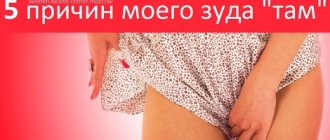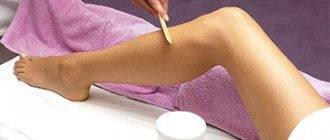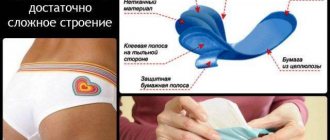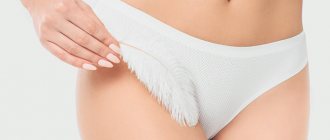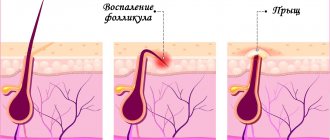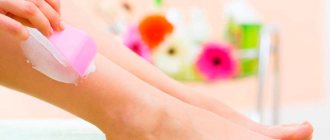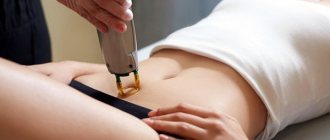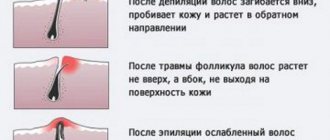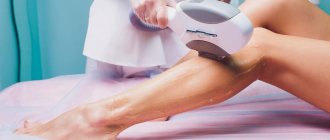Epilation is the removal of unwanted hair on the body. The most common methods are sugaring, photo-, laser and electrolysis. During the procedure, the hairs are removed along with the follicles (roots). This is the main difference from depilation.
Despite all the advantages of hair removal (painlessness, long-lasting effect, the ability to permanently get rid of excess hair), there is also a disadvantage that cannot be ignored. Almost every second girl experiences skin irritation. This is evidenced by small rashes on the dermis, redness, and increased itching. It’s easy to cope with this unpleasant phenomenon; you just need to know the basic methods of skin care after the procedure.
Why does irritation occur?
There are many reasons for the occurrence of irritation on the dermis after the hair removal procedure. Cosmetologists highlight the main ones:
- Mechanical damage to the skin. During the procedure, not only the hair itself is removed, but also the follicle, which significantly exceeds its thickness. This leads to injuries to the superficial layers of the dermis. As a result, red dots appear and the skin becomes dry and tight.
- Inexperience of the cosmetologist.
- Active production of sebum. This process is especially noticeable in people with oily skin. In this case, in addition to the irritation itself, you may encounter the problem of ingrown hairs.
- Anatomical features of the skin. If the dermis is dry or too sensitive, the appearance of irritation after hair removal will not take long to occur. According to statistics, this problem occurs in women with fair skin.
- Poor quality materials. Dull epilator blades, expired wax or sugaring paste will cause skin irritation in 90% of cases. Other more serious problems may also arise: severe allergic reactions, ingrown hairs, the appearance of ulcers and boils, and clogged pores.
- Lack of proper skin care after hair removal. To prevent irritation, use special moisturizers (creams, lotions, sprays).
- Low pain threshold. In this case, local anesthetics are used.
This is interesting! Slight redness of the skin after hair removal is normal. The redness usually goes away within a few hours. Girls with sensitive or too dry skin may experience discomfort for 1-2 days. If after this time the irritation does not go away, the redness and itching intensify, you should immediately seek advice from a cosmetologist or dermatologist.
How to avoid such problems in intimate places
If you follow simple and simple rules for carrying out the procedure at home, the problem can be avoided.
So, the rules for hair removal at home:
- It is necessary to begin the procedure on clean and pre-steamed skin. Wash yourself with an antibacterial agent or soap, and then steam the intimate area by taking a bath. After the bath, wipe with medical alcohol and numb the bikini area, and only after all the steps described above, proceed to the hair removal procedure.
- After the completed procedure, the intimate area must be disinfected. This can be done with ammonia or thermal water.
- After hair removal, you should not sunbathe or use self-tanner for several days.
- If a razor is chosen as an epilator, it must be new and cannot be used again.
- Carry out the procedure with the machine several times in different places. If the machine is new and of high quality, once is enough.
- Even after the best hair removal, it is undesirable to use scrubs and washcloths.
- After epilation, try not to irritate your skin: do not itch or rub it.
- After the procedure, it is prohibited to take a bath or shower for 2-3 hours.
- You should not put on underwear immediately after the procedure.
How to reduce skin irritation after hair removal?
After hair removal, every girl dreams of perfectly smooth skin. To avoid the appearance of redness and itching, you need to follow simple rules before and after the procedure.
Recommendations:
- Light scrubbing of the dermis. For girls with sensitive skin, it is better to carry out the procedure immediately before hair removal. Others can do it the day before going to the cosmetologist. For scrubbing, it is better to use natural products: coffee, honey, cinnamon, ground peanuts, etc. This will reduce the risk of allergic reactions.
- Steaming the skin. A hot shower will help. Warm water helps open pores, allowing hair follicles to pass through easier and faster.
- Treating the skin with antiseptic agents. This could be Miramistin, hydrogen peroxide, or Chlorhexidine. The use of alcohol-containing products is not advisable.
- Anesthesia. When performing photo or laser hair removal, a cosmetologist can apply a lidocaine-based cream to the dermis.
During epilation, the upper layer of the dermis is injured, so the skin needs special care after epilation. Moisturizers are actively used.
If the irritation is severe, swelling or severe itching appears, you cannot do without antiseptics.
Restrictions:
- taking a bath (if possible, abstain for up to 12 hours);
- visit to the swimming pool, sauna, bathhouse (2-3 days);
- tanning (2-3 days);
- scrubbing the skin and using alcohol-based products (1-2 days);
- cosmetic procedures on the epilated area (up to a month).
Your main task after hair removal is to give your skin rest. Try not to wear synthetic, tight-fitting clothes if hair has been removed from your legs. Also forget about wearing tights and stockings for a couple of days.
Having epilated the bikini area, replace tight, constricting underwear with loose cotton sets.
After epilation, pay special attention to your facial skin. Try to go without makeup for a week. This can not only lead to severe irritation, but also cause clogged pores and the appearance of acne.
Step-by-step preparation for hair removal to minimize the appearance of red dots
Properly selected instruments, sterility and careful preparation of the skin play an important role in preventing the appearance of red spots, irritation, and ingrown hairs after the procedure.
Preparation for hair removal consists of the following steps:
- A few days before the procedure, gently scrub the skin in the treated areas and use moisturizers.
- Shortly before epilation, you need to thoroughly steam the skin. Hair will be easier to pull out without causing skin irritation.
- When using an electric epilator, it is recommended to treat the hair surface with talcum powder, which will make the process more effective.
- For the procedure with wax and sugar paste, the treatment area must be thoroughly dried and degreased.
When planning to use a special hair removal cream, you need to prepare a bath where you can comfortably wait the time required according to the instructions and successfully carry out the procedure.
How to carry out the procedure correctly
Irritation on the skin after removing unwanted vegetation may occur due to non-compliance with the rules for performing procedures. The greatest demand is for waxing, sugaring and laser hair removal. Let's talk about them in more detail.
Waxing
Hair removal with wax is a simple procedure that can be done at home. To minimize irritation:
- the length of the hairs should not be less than 0.5 cm;
- heated wax is applied to the body against hair growth;
- remove the wax plate strictly according to hair growth.
Waxing is considered to be the most painful procedure.
…
Sugar depilation
Sugaring has recently become one of the most popular body hair removal procedures.
Advantages:
- use of a hypoallergenic mixture (sugar, lemon juice, water);
- suitable for sensitive skin;
- minimal pain;
- no ingrown hairs.
Just knead the paste in your hands for a few seconds until the mixture becomes soft and pliable. Then it is applied to the skin and rolled out for 10 seconds, capturing the desired hairs. The resulting apilation is removed with a sharp movement of the hand according to the hair growth. After the session, the skin is washed with warm water and a moisturizer is applied.
The disadvantage of sugaring is that after 3-4 weeks, unwanted hair appears on the body again.
Laser hair removal is the optimal solution for removing unwanted hair
Laser hair removal is a quick way to get rid of body hair once and for all. The procedure is carried out only in beauty centers and salons; carrying out such manipulation by a private master is highly undesirable.
The laser beam penetrates deeply into the dermis, heating the cells that contain melanin. As a result, the hair follicle is destroyed. The procedure is quite fast. It takes 10 to 15 minutes to remove facial whiskers. Treatment of the bikini area takes 20-25 minutes.
To consolidate the result, experts advise carrying out several similar procedures, explaining this by the fact that a person has follicles that are in the “sleep” phase.
The main condition for successful laser hair removal is the required hair length. They should not be about 1.5-2.5 mm.
Advice from a cosmetologist! Laser hair removal is a reliable way to remove hair from the body. The advantages of the procedure are obvious: minimal pain, long-lasting effect, short session duration, absence of ingrown hairs.
How to deal with ingrown hairs?
One of the most common problems after hair removal is ingrown hair. Growing hairs cannot break through the layer of keratinized particles on the surface of the skin, so they begin to grow directly under it. This is fraught with the development of inflammation and unpleasant sensations.
In this case, it is easier to prevent a problem than to look for a way to solve it. And the best assistant here will be a scrub. It should be used several hours before the procedure to cleanse the surface of the dermis and simplify the process of hair germination. There are special products against ingrown hairs. If such a problem does arise, under no circumstances should you try to squeeze out the hair.
Top 5 ways to quickly remove skin irritation
What to do if irritation appears on the skin after hair removal?
We recommend the following care solutions:
- Moisturizing creams and lotions. Pay careful attention to the composition of the products. There should be no parabens, fragrances or fragrances. These chemical components will only increase irritation.
- The use of antiseptic ointments.
- Using powder. Powder should not be used for dry skin; it can lead to peeling of the dermis.
- Treatment of skin areas with solutions of “Chlorhexidine” or “Levomycitin”.
- Use of anti-burn drugs.
In the modern world, a woman is accustomed to looking luxurious. Excessive hair on the body does not fit into the canons of beauty. All that remains is to choose a hair removal technology.
We recommend laser hair removal - a modern and safe solution with a minimum of contraindications. Usually the irritation is barely noticeable and goes away very quickly - the cosmetologist will give all the necessary recommendations.
Care after using the epilator
Many girls prefer to remove hair with a special device - an epilator. To avoid unpleasant consequences, before the procedure, take a shower with a scrub, dry your skin well with a towel and treat it with an antiseptic. This will help prevent the appearance of red dots after hair removal and infection of the pores. Furacilin, Miramistin and thermal water also help to avoid irritation. But it’s better to avoid alcohol – it dries out the skin.
This procedure must be carried out especially carefully the first time. Skin that is not accustomed to such exposure may react with severe irritation. Therefore, to begin with, it is recommended to treat small areas, and after the procedure, apply the disinfectant composition again. In this case, under no circumstances should you rub the skin.
Types of post-depilation products
In the fight for smooth skin, waxing, sugaring, chemical and hardware hair removal with laser or electricity are used. These procedures leave irritation on the skin, provoke allergies, pain, burning and cause ingrown rods. Special products after depilation and hair removal remove discomfort and slow down hair restoration.
Cosmetics
Salons and stores offer a wide range of post-hair removal products. Depending on the degree of dryness and sensitivity of the skin, the following textures are selected:
- water with added minerals and plant extracts;
- lotion;
- lotion-emulsion - has increased moisturizing properties;
- lotion-serum - highly concentrated light structure for sensitive, problematic skin prone to rapid hair growth;
- biphasic lotion - combines water enriched with minerals and vegetable oils, therefore it is used for quick cleansing of sugar paste or loose wax;
- milk, cream and mousse - suitable for increased sensitivity and a tendency to clog pores;
- serum - has a higher concentration of active components compared to all other textures;
- gel and cream-gel - recommended after shaving for men and women;
- cream - dense structure for dry, flaking-prone skin;
- active paste against ingrowth.
Beach and solarium lovers should pay attention to products with UV filters. Along with moisturizing, reducing redness and slowing down hair growth, sensitivity to ultraviolet rays decreases. This prevents the appearance of pigmentation, which is encountered after depilation, laser, photo and electrolysis, so skin protection during tanning is necessary!
Sunscreen lotion after depilation from WhiteLine – TOP formula
After hair removal, it is important to soften and soothe the skin so that irritation does not develop into an allergic reaction and folliculosis. For this purpose, plant extracts are added to cosmetic products:
- aloe vera;
- dwarf palm;
- cucumber;
- pumpkin seeds;
- narcissus root;
- tea tree;
- seaweed;
- oats;
- grapefruit;
- walnut shells;
- clover;
- cotton;
- sugar beets;
- witch hazel.
Together with these ingredients, essential oils help disinfect the skin, make it velvety and well-hydrated:
- pharmaceutical chamomile;
- common yarrow;
- eucalyptus;
- geraniums;
- ylang-ylang.
If you have dry skin and after depilation you experience peeling, the appearance of red spots and irritation that does not go away within 1-2 days, choose cosmetics with panthenol, lanolin, allantoin, shea butter or almond oil.
In post-depilation products, sugar beet extract is often hidden under the term betaine. The mysterious substance azulene is the main component of the essential oils of chamomile, yarrow, eucalyptus and geranium.
Pay attention to the following ingredients in cosmetics for skin care after hair removal:
- papain - slows down the germination of the bulb, destroying the keratin found in it;
Read more about products that slow down hair growth in the article - Products that slow down hair growth are a good addition for depilation.
- mandelic, salicylic, citric and other fruit acids - accelerate tissue restoration, disinfect and protect from the sun;
- menthol - cools, relieves pain and burning;
- vitamin F - oleic, arachidonic, linoleic and linolenic essential fatty acids that promote healing and maintain the natural pH balance of the skin;
- vitamin A is an antioxidant that prevents the development of decrepitude of the epidermis and the appearance of spots after depilation and hair removal;
- triclosan - reduces oiliness, tightens pores, prevents flaking, has an antiseptic and antifungal effect.
Men and women who prefer shaving will benefit from products with the patented Decelerin complex. The substance restores protein cells necessary to preserve the structure of the skin, stimulates wound healing, making the surface of the epidermis smooth. With regular use of Declerin, hairs become softer, stubble growth slows down, and the number of ingrown hairs decreases.
Gallery: post-depilation products
Lotion after sugaring Irisk - soothes and disinfects the skin, slows down hair growth with regular use Cream for restoring skin pH Aravia contains ylang-ylang essential oil, suitable for use after electrolysis with a home epilator and razor Start Epil thermal water removes wax and paste residues and quickly removes irritation Lady Caramel cream from the Elfa brand moisturizes, relieves irritation and slows down hair growth due to the presence of narcissus root extract ItalWax active paste is specially created to combat ingrown hairs under the skin pH restoration milk with aloe vera extract from Saona Cosmetics removes pain and peeling of the skin after hair removal White line cooling gel is suitable for those who experience burning and pain after waxing or sugaring Korean TNL serum softens, moisturizes the skin, suitable for daily care DepilFlax mousse is used to slow down hair growth, suitable for daily use between procedures depilation and hair removal
Oils
After depilation, residues of wax or sugar paste remain on the skin. These are fat-soluble substances, so they are removed with special means. Such formulations contain purified mineral and cosmetic oils:
- almond;
- wheat germ;
- grape seeds;
- soy;
- sunflower;
- olives.
They destroy the sticky composition of the depilatory mass and at the same time care for the skin - moisturize, soften, prevent the spread of irritation, the appearance of red spots and pimples. In products worth up to 200 rubles. Instead of oils, liquid paraffin is often used, enriched with plant extracts and esters with antiseptic and soothing effects:
- aloe vera;
- chamomile;
- plantain;
- tea tree;
- grapefruit.
A mandatory ingredient in such products is vitamin E!
Gallery: oils for removing wax and sugar paste residues
Cooling oil from Start Epil with mint extract and vitamin E Oil for sensitive skin with lavender extract from ARAVIA Professional Carribean oil for removing wax residues from Depilflax can be used for venous and capillary meshwork Natura oil with menthol from White line Oil with UV filters Eva Bond Beauty Collection “Face Wax” from Irisk for the face Italwax oil with lemon extract
Video: aftershave care with natural oils for men and women
Pharmacy drugs
Pharmacy creams, ointments and solutions are used after all types of depilation and hair removal to reduce negative symptoms caused by hair pulling or burning. The usefulness of these tools is based on the following actions:
- antiseptic;
- bactericidal;
- anti-inflammatory;
- wound healing.
Among consumers, Bepanten and Panthenol ointments were highly praised. According to reviews, the product removes irritation in 1–2 days, reduces the visibility of red dots, relieves burning, flaking and itching after wax or sugar hair removal.
Panthenol from EVO is a universal product for all skin types, which is sold in pharmacies and cosmetic stores.
After depilation, my legs were simply burning and covered in red spots. In general, the spectacle is not for the faint of heart. In a panic, I began to look for ways to alleviate my suffering. I came across a forum that recommended after-sun products with panthenol. I immediately remembered Panthenol. I read on the packaging that the cream helps normalize protective functions and soothes the skin. I applied it three times and at night. After the first use I felt relief. Then the irritation gradually subsided. Now I have smooth beautiful legs.
kostochka_v_gorle
https://irecommend.ru/content/spas-posle-depilyatsii-zhutkie-foto-do-i-posle
Calendula ointment and tincture, Levomekol, as well as soap with birch tar can cope well with pustules, folliculosis, and pain. They dry out inflamed pores, draw out pus and promote rapid healing of painful tumors. It is recommended to use such products after shaving, especially if the area being treated has coarse black hair. Ointments are suitable for men and women. Tinctures and soaps should not be used if you have sensitive, dry skin.
Levomekol copes with irritation after hair removal and prevents the development of fungus on the skin
During the first 4–5 depilation procedures, redness and slight itching begin. To avoid these symptoms or significantly alleviate them, you can apply Levomikol immediately after depilation. The ointment, even taking into account the fact that its cost has recently increased, is inexpensive, but at the same time very effective. 1 tube was enough for me, it was enough for exactly 4 depilations, and then the skin didn’t react like that, the need for Levomikol disappeared.
Maria Tsareva
https://xn--80avnr.xn--p1ai/%D0%9C%D0%B5%D0%B4%D0%B8%D1%86%D0%B8%D0%BD%D0%B0/%D0% 9B%D0%B5%D0%B2%D0%BE%D0%BC%D0%B5%D0%BA%D0%BE%D0%BB%D1%8C/%D0%9E%D1%82%D0%B7 %D1%8B%D0%B2%D1%8B/6879576
When performing depilation yourself, thoroughly disinfect the skin. Proper disinfection will help avoid allergic reactions, burning, irritation, the appearance of pustules and fungal infections. Chlorhexidine, an inexpensive analogue of the widely advertised Miramistin, is suitable for this purpose. The universal product is used to treat the skin on the body, face, sensitive areas of the bikini area and armpits, as it does not contain alcohol. For the same reason, an antiseptic cannot be used for pre-treatment - Chlorhexidine does not kill all pathogenic bacteria and does not degrease the skin. Cortisone ointment has similar properties. After wax, sugar, laser hair removal, it removes burning sensation and promotes rapid healing of damage that occurred in the layers of the epidermis when hairs were burned out.
Cosmetologists use Chlorhexidine as an emergency antiseptic, but on an ongoing basis for treating the skin before and after depilation, they recommend using professional cosmetic products from one manufacturer
I think everyone should have one. I disinfect wounds with it, and it doesn’t sting or stain anything, like, for example, from peroxide, brilliant green and iodine. Everything heals much faster. I also use it for cleansing my face and plucking my eyebrows. I apply it immediately after epilation (with wax or an epilator, and even when shaving, I think it won’t hurt either), the red spots go away faster, and all sorts of bad bacteria are killed.
Esa
https://irecommend.ru/content/snimaet-razdrazhenie-posle-epilyatsii-da-i-voobshche-chudo
Eplan is an antiseptic that many customers use after electrolysis. It treats burns, relieves inflammation, speeds up skin healing and prevents the appearance of scars that are characteristic of this type of hair removal.
My master recommended Panthenol or calendula tincture. I used both. They are very inexpensive and help a lot. I also tried an ointment such as Contractubex for the treatment of age spots. It’s expensive, about 500 rubles, but I didn’t see much effect. I also now use Eplan instead of Panthenol, it helps with burns and promotes skin regeneration. Eplan helped me more than Contractubex, and it costs less (149 rubles).
maya2795
https://otzovik.com/review_2377652.html
Eplan cream should be used by everyone who prefers electrolysis, depilation with hot wax or paste.
Home Recipes
At home, after depilation and hair removal, use decoctions of herbs that have an antiseptic and soothing effect:
- pharmaceutical chamomile;
- oak bark;
- sage;
- peppermint;
- thyme;
- marshmallow root;
- plantain.
Soak a cotton cloth and a wide bandage with a strong infusion and wrap it around the area where hair was removed. Leave the compress on for 10-15 minutes, remove it and apply a moisturizer with glycerin, aloe vera, cucumber, eucalyptus, tea tree or calendula extract to the skin. Add 2 drops of lavender, juniper, cedar, vetiver or ylang-ylang essential oil to a teaspoon of the product. They will enhance the moisturizing effect of the cream and also help to quickly relieve discomfort after all types of depilation and hair removal. You can use base oils as a base:
- olive;
- linen;
- grape seeds;
- corn;
- almond.
This composition is used only after hair removal using a cold method or using wax in cartridges!
To relieve swelling and prevent pigmentation, use lemon juice or apple cider vinegar. Rub the skin after depilation until the substance evaporates completely. If you suffer from dryness and flaking, dilute the main component with mineral water in a 1:1 ratio. After rubbing, use a moisturizing gel, milk, or make a compress of low-fat kefir.
Apple cider vinegar relieves swelling after depilation and prevents the development of varicose veins
I used it immediately after epilation: I sprayed the skin with undiluted vinegar and waited until it was completely dry. Of course, it stung terribly, but you can endure it. After this, I smeared the skin with Lassara paste - it relieves redness and inflammation well. I sprayed it every other day. Over time, I noticed that the hair stopped growing in, there was much less of it, very sparse, and in some places bald spots appeared - the hair hasn’t grown there for about a month, and if something comes out, it’s fluff, which is invisible.
olever
https://irecommend.ru/content/ispolzovala-protiv-vrastaniya-volos-posle-epilyatsii-i-zametila-plyus-eshche-1-effekt
Mineral water and olive oil
In a spray bottle, combine half a liter of still mineral water with two tablespoons of filtered olive oil. Immediately after depilation, shake the mixture and spray the treated surface. The composition fights flaking and dryness, relieves redness, softens the skin.
Video: mask to slow down hair growth with a decoction of walnut membranes
Datura and calendula
Ingredients:
- 3 tbsp. l. dry dope leaves;
- 1 tbsp. l. calendula flowers;
- 1.5 liters of water;
- 1 tbsp. l. olive oil.
Cooking steps:
- Bring the water to a boil.
- Place the herbs in a thermos and pour boiling water over them.
- Leave for 2-3 hours.
- Strain the infusion.
- Pour into a spray bottle.
- Add olive oil.
Apply lotion after waxing or sugaring twice a day for two weeks.
Composition properties:
- reduces irritation and the appearance of red dots;
- dries out pimples;
- fights inflammation;
- inhibits hair growth.
Datura is a poisonous plant; its decoction should not be ingested!
Cooling lotion with menthol
Ingredients:
- 2 tbsp. l. calendula flowers;
- 2 tbsp. l. lemon balm;
- 1.5 liters of hot water;
- 20 drops of menthol oil;
- 10 drops of tea tree oil;
- 2 tbsp. l. castor oil.
Cooking steps:
- Place calendula and lemon balm in a thermos and fill with water.
- Close tightly and leave for 12 hours.
- Strain and cool the infusion.
- Add oils and pour into a spray container.
Spray the skin after hair removal to relieve pain, burning and redness.

